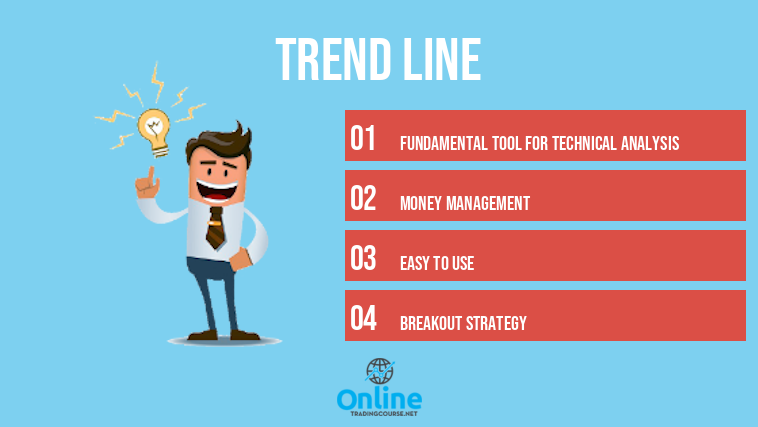
Trend Line
The trend line is one of the fundamental cornerstones of the whole trading sector and of the technical analysis of the financial markets. Countless traders have used them for their trades since they were first invented decades ago.
Trend Lines are a trading indicator used to track down trends and recognize what stage of their existence they are in. This analysis tool presents only one problem: although it is simple to use and plot on the price chart, it is subject to strong discretion.
Throughout this guide we are going to offer practical advice on how to use parameters and the trend line in the investment phase. We are also going to explain the most effective methods for plotting them on a price chart with a fair dose of objectivity.
So, we advise you not to miss this guide on OnlineTradingCourse.net. Trend line is a highly effective indicator (their validity is equal to that of other important indicators such as Ichimoku) which can help any financial operator to improve his performance during the negotiation phase.
Data and information from trend lines come in handy in any market situation and on any financial asset available on the trading platforms that are used.
Before starting, we would like to note that thanks to the eToro platform it is possible to copy, in a completely automatic way, what the best traders in the world do.
eToro has, in fact, created and patented the innovative Copy Trading, a system that helps you to find traders who earn more (with less risk) and copy them automatically.
Beginner traders have the opportunity to immediately get the same profits as the best traders in the world and can also learn from them.
You can sign up for free on eToro by clicking hereIndex
What are Trend Lines?
What exactly is a Trend Line? Before continuing and discussing in detail how trend lines are used during trading, it is necessary to understand exactly what they are and how they work.
To understand this, we need to talk about the markets and how they work. Each market is a place where goods of all kinds are exchanged. But, while in your local market you buy and sella fruit and vegetables, on the financial markets you are trading investment assets.
But if you think about it, there is no substantial difference: all markets work the same way.
The places of exchange have one element in common: they are the place where the supply and demand of a given good or stock meet. The result of the balance of forces between supply and demand is expressed by the price of the financial asset itself.
The price is a constantly changing element because the negotiation on national and international markets practically never stop. Supply and demand are constantly changing, based on factors inside and outside the market itself.
Precisely these constant changes in price, in addition to the changes in the mechanism of supply and demand, generate trends. A trend represents the addition of the time factor to a market, because it shows the prevalent price trend.
Trend definition
To understand the concept of Trend Line it is necessary to specify briefly also what a “trend” is.
Here is an exhaustive definition:
When the market makes an evident and lasting upward or downward movement, we can define it as a trend or market trend. Identifying the beginning and end of a trend is a key component of a market analysis. A trend can be identified in the graph of a single asset, in a sector or even in an interest rate or return on a stock.

In the above image you can see the example of a trend as it appears on the classic price graph a trading platform.
In particular, the graph shows the trend in the price of the Dollar against the Yen (USD / JPY). The time frame described is the change that occurred during a trading day.
We can observe that the upward trend has pushed the value of the dollar to strengthen a lot against the yen. In a single day, the price went from 97,200 to 104,400. Therefore, at that moment, 104,400 yen were needed to “buy” 1 dollar on Forex.
There are 3 types of trends:
- Bullish trend: it occurs when the price of a good or market stock shows an uninterrupted succession of rising highs and lows.
- Bearish trend: downward trends are recognized when the price of a good or security shows an uninterrupted succession of decreasing highs and lows.
- Side trend: with sideways trend the market does not have a precise direction, but the price continues to oscillate around the same price.
Each directional trend is always a succession of highs and lows, because no market continues to move in the same direction without any pause. The successes of highs and lows that increase or decrease, occur thanks to the so-called corrections and rebounds.
The former occur when, in a bullish trend, the price begins to move downwards but without breaking the price stock of the previous low.
The latter occur when, in a bearish trend, the price moves upwards for a certain period, but without causing the main trend to stop.
Definition of Trend Line
Trend lines are nothing more than the ideal tool to identify the presence of a trend on the market. A fundamental step for every subsequent action to be taken when investing in a market.
Thanks to Trend Lines, a trader can immediately understand when a trend is taking place on the market, how long it lasts and what are the conditions and bases on which a continuation or interruption can take place.
With such a data available, 50% of a trader’s work is practically already done.
How to draw a Trend Line?
Drawing a trend line on a price graph requires no special effort, but be careful, this is only appearance. In fact, drawing Trend Lines well is complex and only well positioned trend lines return really useful information.
To trace them, it is necessary to combine the points of the succession of the maximums and minimums increasing in an upward trend and the maximums and minimums decreasing in a bearish trend.

What is the main difficulty in tracing the trend lines? By doing analysis and trying to draw the trend lines on a graph, you can notice that it is possible to draw lines starting from different points on the price.
Precisely for this reason it is not easy to trace the Trend Lines. There is a strong discretionary component in the process and this can lead traders to incorrect evaluations or to want to trace more Trend Lines than they actually need. How to draw the lines effectively, then?
The well-drawn trend lines must follow the price in its bullish or bearish trend and consequently they can be considered as dynamic supports and resistances. In fact, the operation of the Trend Lines is not very dissimilar from that of supports and resistances concepts well know to those that operate with online trading.
The two main types of trend lines can be assimilated respectively to supports in the case of a bullish trend line or to resistance in the case of a bearish trend line. To recap:
- With rising prices we can draw the so-called “support” trend lines. They “support” the price in the sense that they are traced on the succession of increasing peaks and troughs and therefore below the uptrend, then they follow it in its development until the trend stops for some reason.
- With falling prices, however, “resistance” trend lines are drawn. In this case, the trend line is drawn on the different points marked by the decreasing lows that characterize the markets that move with the descent of the price towards ever lower quotas.
Trading with Trend Lines
Having faced the theory, we can go on to talk about practice, that is: how to trade using the signals coming from the Trend Lines?
Financial operators use trend lines mainly to apply “breakout” strategies. The breaking of a trend line, in fact, is one of the most reliable signs that can cause the notorious market trend reversals.
Why do you tend to trade especially on the breaking moments of a trend line? When a trader identifies an asset rather than another where to make an operation, he will almost always find himself in front of a market that is already in trend. So, how can he make a decision on how to invest?
In an already trendy market, entering could be a waste:
- It si difficult to decide on an ideal entry point
- The preconditions for the current trend are unknown
- It is not known how long this trend could last
- Entering the market late would result in a waste of time
For this reason, those who negotiate based on technical analysis tend to wait for the end of the current trend to enter the market when the next one is formed. It will thus be possible to exploit it to make capital gains throughout its duration.
So, it is essential to recognize a reversal signal: it heralds that the trend is about to change and that could be an opportunity not to be missed to negotiate.
Breakout strategy
We are confident that it will now be much easier for you to understand the importance and effectiveness of trend lined for analyzing graphs. Thanks to the trend lines it is possible to move on different levels of interpretation of what id happening on a market.
It is interesting to understand what happens from a psychological point of view among the traders who witness the breaking of a trend line. We can immediately see that it determines that the forces, which had dominated the market up to that point, are now losing control of the situation.
In the case of a bullish trend, it can be imagined that buyers are no longer convinced of the continuation of the upward price rush. The trend therefore begins to show sign of slowing down because some buyers are starting to exit the market, causing the bullish trend to lose strength.
Many of them are preparing to open an opposite position because they now expect the general conditions to change. Exactly the same thing, but in an inverted sense, it happens when we are towards the end of a bearish trend, in this case, however, it is the sellers who no longer seem convinced of a further depreciation and are then preparing to exit the market.
When the tension finally reaches its maximum, the support or resistance trend line gives way and very often happens that the price explodes, moving strongly in one direction or the other as appropriate.
Operational trading signals
Let’s take the case where a bullish trend line breaks, when it is found, it is reasonable to expect that the bearish forces have taken over and are now still willing to push the price in the opposite direction.
Here, this is the moment when a bearish turnaround occurred. Traders who, thanks to the Trend Lines, predicted it in time, entered the market with a “Short Selling” position. The same overturned speech works for a break of the bearish trend line, the signal in that case is “Buy”.
Practical tips for using Trend Line
As you understand, using trend lines when investing is not particularly difficult. But now we want to give further practical advice that allows you to recognize any false signals that lead to making wrong decisions on the market.
First you need to make sure that the market is really in a clear trend phase. If you are a beginner, remember that your worst enemy is the side stages of the market. Only professionals manage to operate successfully when the market does not have a precise direction.
The important thing is to always use the utmost caution and operate on the suggestions offered by the market itself. You don’t have to throw yourself into arbitrary interpretations, just evaluate objectively what you see without expecting what you have imagined to happen.
Trend lines can also generate false signals. Fortunately for those who use them, they are generally a fairly reliable indicator. Only in rare cases can they attempt real ambushes that can generate losses.
This occurs especially in times when a market is characterized by strong volatility and directionality. If you are unable to manage volatility, therefore, we invite you not to select the Forex market as an investment asset which is all too volatile. Better to turn to other calmer markets such as that of raw materials (but also better to avoid negotiating oil here).
Recognize a reliable Trend Line
How can you understand the degree of reliability of a trend line? In truth, it is not very difficult to understand it. Once you learn the basic principles, it is as simple as drinking a glass of water. Evaluating the degree of reliability of a trend line is useful both to enter the market and to understand when the time has come to leave it.
We summarize the evaluation criteria in 2 points:
- Degree of Inclination: a trend line can be more or less inclined. The market is always looking for new levels of balance and therefore tends to regulate itself. For this reason, when a very angled trend line breaks, the resulting signal is always much more reliable than that obtained from very little inclined trend lines. The breakdown of trend-online with very pronounced inclinations is an excellent signal to enter the market and place a trade.
- Contact Points: just as in the case of supports and resistances, even the trend lines can be considered more solid as the contact points they have with the price. The more many times the trend line has been tested without breaking, the more the market players will be inclined to respect them. When the break occurs, the resulting signal is always very important.

Look at the image above. The resistance Trend Line here was touched by the price in 4 points before being overcome by an explosion of bullish volatility in the breaking point highlighted.
This testifies how strong the signal coming from a trend line very tested by the price can be. As can be seen after the great rise, the market returns to the side phase, but, those who entered the market on the break, have certainly done great deals.
Trend Line and Money Management
Even when using Trend Lines it is essential to always protect your investments. Let’s say you have a capital to be used on the markets which amounts to 1000€, how much do you think you are investing on breaking a trend line? 200€? Or maybe 500€
It is not a good idea to invest such amounts, do you know why? Because they represent a figure that is too important compared to your investment capital. 500 euros, to be exact, is half of your total capital. What would happen if the chosen signal turned out to be false?
You could lose all the capital invested. Better to avoid using such a sum and set the Stop Loss to a maximum 5% of your total capital. Speaking of 1000€ your maximum risk must be 50€.

Learn Online Trading
For those who really want to learn online trading we suggest downloading the Free ForexTB broker course.
It is one of the most downloaded courses because:
- It is complete
- It is simple to study even for a beginner
- It is practice oriented
- It is completely free (just sign up to download it)
Read also our full review on ForexTB
Conclusions on the Trend Lines
Trading on financial markets can be simple… if you know how to do it! As we have seen, the Trend Lines are quite intuitive in their use but are at the same time a very powerful tool (especially together with the economic calendar).
Use them carefully for your trades and the satisfactions could be large.
Read also: RSI Oscillator
Trend lines identify a market trend.
In this case, the support Trend Lines can be traced.
In this case the resistance Trend Lines can be traced.
